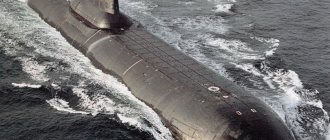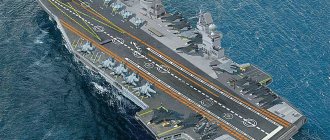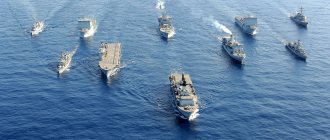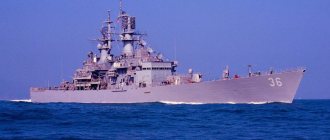In 2022 and beyond. Plans for the construction of nuclear submarines for the Russian Navy
SSBN "Prince Vladimir" after arrival at the duty station, July 2020.
Currently, the United Shipbuilding Corporation, in the interests of the Navy, is implementing two large and complex projects for the construction of nuclear submarines. At the same time, multi-purpose nuclear submarines Project 885(M) "Yasen" and strategic missile carriers Project 955(A) "Borey" are being built. The Navy has received several of these two types of submarines in recent years, and two more are expected to be delivered in the coming months. Then USC will have to complete the construction of 11 more buildings.
Current plans
Current plans for the development of the Navy’s submarine forces provide for the construction of 10 strategic missile submarines Project 955 and 955A (“Borey” and “Borey-A”).
Four of them have already been handed over to the customer and are in service. The Navy will also receive a total of 9 nuclear submarine missile cruisers Project 885 and 885M (“Yasen” and “Yasen-M”). So far, this construction program has shown more modest success - only two such ships have been commissioned. Last December, Deputy Defense Minister Alexey Krivoruchko revealed plans for the next few years. He said that by 2027, 14 nuclear submarines of two main types will be built. The construction of ships is underway (Severodvinsk). It will have to commission one multipurpose and strategic submarine each year. It is important that the presence of such orders made it possible to fully utilize the production capacity of the enterprise.
Multipurpose nuclear submarine "Kazan", May 2022
The plans disclosed by the Deputy Minister of Defense have already been partially implemented. In May of this year, the first nuclear submarine of the updated Project 885M, Kazan, was commissioned into the Navy. Several more orders are in advanced stages and will be completed soon. A few days ago, the current schedule for such work was revealed.
On September 3, Interfax published an interview with USC General Director Alexei Rakhmanov. Among other topics, it discussed the prospects for underwater shipbuilding. The head of the corporation said that by the end of this year, two new submarines will be delivered to the customer - the SSBN Prince Oleg and the Novosibirsk APRK.
The construction of two types of ships will continue. As a result, two more ships will be tested next year. These are the strategic Generalissimo Suvorov and the multipurpose Krasnoyarsk. Previously it was reported that the Suvorov could be delivered to the customer by the end of 2022, but now this event has been shifted to next year. Krasnoyarsk will begin service in 2022, as previously planned.
Ceremony of laying down the submarine "Prince Oleg", July 2014
Another 9 nuclear submarines of two types are at different stages of construction, and their testing with subsequent transfer to the customer remains a matter of the distant future. It is curious that such a number of buildings on the stocks was achieved just a couple of weeks ago. On August 23, two Borei-A missiles were laid down at Sevmash.
Construction successes
The construction of nuclear submarines is particularly complex and takes a lot of time.
In addition, at the stage of mastering serial construction of a new project, various problems may arise, due to which it is necessary to revise the schedule. As recent news shows, Russian shipbuilding managed to overcome these difficulties and reach the required pace of nuclear submarine construction. It should be recalled that the construction of the lead SSBN Project 955, “Yuri Dolgoruky,” lasted from 1996 to 2008. Then several years were spent on testing and modification, and only in 2013 the ship entered service. In the same year, the Navy accepted the Alexander Nevsky submarine, laid down in 2004. The Vladimir Monomakh was built in 2006 and entered service at the end of 2014. The first representative of Project 955A, “Prince Vladimir”, was built in 2012-18. and has been serving since June last year.
The withdrawal of “Prince Oleg” from the boathouse, July 2022.
This year the Navy will receive the Prince Oleg SSBN. This ship was under construction from July 2014 and was launched six years later. Testing recently began in May, and it will be handed over to the customer by the end of the year. The laying of the next ship, Generalissimo Suvorov, took place several months later, and it is scheduled to be delivered next year.
The situation in the APRK sector looks similar. More than 16 years passed from the laying to the launch of the lead Yasen. After another 4 years, the flag was raised at Severodvinsk. The first Yasen-M, Kazan, was built from 2009 to 2022. In May of this year, this nuclear submarine was transferred to the Navy. The Novosibirsk, expected this year, was laid down in mid-2013 and launched at the end of 2019. The next Krasnoyarsk was on the slipway from 2014 to 2022.
Thus, in recent years, Sevmash and USC as a whole have been able to resolve all construction issues and increase the pace of work. At the moment, the construction of one nuclear submarine, Project 955(A) or 885(M), takes no more than 6-8 years. This is fully consistent with the current plans of the Ministry of Defense and the Navy - and allows us to expect that the construction of the two series will be completed on time.
Pennants of the future
According to the latest statements by A. Rakhmanov, until 2027, two nuclear submarines will be commissioned annually - one ship of each serial project. There is every reason to believe that such plans are fully consistent with the capabilities of industry. Moreover, it is easy to notice the presence of some time reserve.
The second Yasen-M - Novosibirsk before launching, December 2019.
The SSBN Generalissimo Suvorov is expected to be launched in the near future. Next year it will undergo testing and will likely enter the fleet. There are four more similar ships at various stages of construction. With the annual delivery of one submarine, the entire series will be completed in 2026 or a year later. In the latter case, there is a time reserve of one year.
The situation is similar with the construction of Yaseni-M. In 2021-22 The Navy will receive two already built submarines - one is currently undergoing testing, the second is being prepared for them. Then, starting in 2023, five more will be commissioned. Accordingly, the last of the planned cruisers will enter service in 2027. However, in the case of Project 885 (M), there is no noticeable time reserve.
Update issues
The nuclear submarines under construction are distributed between the Northern and Pacific fleets and complement the existing submarine forces. In the medium term, they will become a replacement for ships of older types, which will be written off as they become morally and physically obsolete. In this case, special attention should be paid to the development of CTOF.
Launching ceremony of the Krasnoyarsk, July 30, 2022
Of the four Boreevs built, two became part of the KTOF. The place of service of the new “Prince Oleg” has not yet been specified. The next two SSBNs will also go to the Pacific Ocean. Thus, by the middle of the decade, out of seven ships built, at least four will be at the disposal of the Pacific Fleet. The reasons for this are simple - KTOF still uses outdated SSBNs, Project 667BDR "Squid". In the foreseeable future, they will be written off and replaced with modern Boreys.
In the case of multi-purpose submarines, such trends are not observed. They will continue to be divided equally between the two fleets. The first two Yasen are already serving in the Northern Fleet, and the next two will be sent to the Pacific. The existing group of multi-purpose nuclear submarines of the two fleets so far meets all the requirements, and forced re-equipment of one of them is not required.
Great achievements
Thus, over the course of several years, the shipbuilders of Sevmash and USC, as well as related enterprises, were able to ensure that the production program for new nuclear submarines reached the required pace.
The result of this in 6-7 years will be the most serious renewal of the fleet of strategic and multi-purpose missile submarines. At the same time, the overall potential of the submarine forces and the fleet as a whole will increase. It should be noted that Russian shipbuilders still face a rather difficult task. In the coming years, they will have to maintain the achieved pace of work, on which the future of the Navy depends, incl. naval components of strategic nuclear forces. However, there is hardly any need to worry about this. Despite all the difficulties, USC has already shown and confirmed its potential and capabilities. This means that by 2027 the fleet will receive both required series of submarines.
Top 5 most formidable submarines in Russia
Our country's submarine fleet has always represented a force that could not be ignored. After the collapse of the USSR, the development program of the submarine fleet in Russia slowed down for well-known reasons. However, since the 2000s, such a breakthrough has been made in this regard that even many foreign experts were surprised by the changes taking place. At the same time, the Russian leadership is not going to stop there. We will not reveal all the secrets of modernization and the creation of new submarine projects; we will only talk about those Russian submarines that, according to our overseas partners, are the main threat to them.
"Pike-B"
The first place in this list is occupied by Project 971 nuclear submarines “Shchuka-B” (aka “Akula” according to NATO classification). They belong to the third generation boats and began entering service with the fleet in 1984. The latest advanced modifications pose a particular danger. Multi-purpose "Pikes" are designed to intercept enemy submarines, protect their own and destroy other surface ships. In addition to eight torpedo tubes capable of firing torpedoes, rocket-torpedoes, as well as installations for launching cruise missiles (including those with nuclear warheads), no less important “weapons” of the “Akula” are its stealth and low noise.
"Halibut" and "Varshavyanka"
The second and third positions are occupied by the sister submarines Halibut (Project 877) and Varshavyanka (Project 636). Both types are the quietest in their class; the Varshavyanka even received the nickname “Black Hole” in NATO. The designers initially (the main project was created in the 70s of the last century) were given the task of creating a submarine that was guaranteed to emerge victorious in a duel situation. That is, she had to detect and destroy the enemy submarine before it understood anything. And this task was completed. The Halibut is armed with six torpedo tubes, and the Varshavyanka (these submarines of the latest version are being built today for the Black Sea Fleet) also has launchers for firing Caliber cruise missiles. Both types of submarines are readily purchased abroad. Our Halibuts and Varshavyankas are already serving in Algeria, Vietnam, India, and China.
"Borey"
The Project 955 strategic submarine missile carrier Borei was also included in the list of storms of the seas. This is the first submarine entirely designed and built in post-Soviet Russia. The Borei is armed with ballistic missiles with nuclear warheads and torpedo tubes capable of firing an entire arsenal of weapons to destroy surface and underwater ships. The nuclear reactor provides the submarine with an underwater speed of up to 30 knots; it is capable of diving to a depth of 480 m and staying under water for 90 days. Three boats of this class are already in service with the Russian Navy and are capable of performing their assigned mission anywhere in the World Ocean. By 2022, the Russian Ministry of Defense plans to put eight more Boreevs into service.
"Ash"
Well, the latest nuclear submarine of Project 885 “Ash” closes the list of “thunderstorms from under the water”. This is the most modern and most expensive Russian nuclear-powered multi-purpose submarine of the fourth generation. The first ship "Severodvinsk" entered the Northern Fleet in 2014. Sufficiently powerful weapons (homing torpedoes and cruise missiles with a firing range of up to 400 miles) allow the Yasen to hit targets underwater, on the water and on land equally effectively.
The boat's hull is made of low-magnetic steel and covered with rubber, which makes it invisible to the enemy. The huge spherical antenna of the hydroacoustic complex, located in the bow of the submarine, allows sailors to hear the enemy ship long before it detects them. An underwater speed of 35 knots, the ability to dive to 600 m and stay under water for up to 100 days make the Yaseni a very powerful and modern weapon.
“Doomsday Weapon”: Americans were horrified by the new Russian super-submarine
The unique nuclear submarine of Project 09852 Belgorod, whose exact characteristics are classified to this day, was launched on April 23, 2022. It is she who will have to carry the “doomsday weapon” on board. The Americans did not hide the fact that the submarine horrified them. According to experts, “Belgorod” will be able to create even a tsunami due to its advanced weapons.
Superweapon for new submarines
The Russian Navy has been on an unprecedented rise in recent years. The authorities pay special attention to the submarine fleet. Every year, the newest submarines leave the shipyards, the purpose of which will be combat duty at sea borders and maintaining a strategic balance, taking into account the unpredictability of “Western partners.”
The United States has more than once expressed dissatisfaction with the increased power of the Russian fleet, noting that Russian submarines already create a lot of headaches for the NATO military, which constantly loses them in one ocean or another.
So, just recently, in March of this year, the United States and its allies launched an operation of unprecedented scale to search for the Rostov-on-Don submarine, which was “lost” in the Mediterranean Sea.
As the media wrote, the submarine suddenly disappeared from all NATO military radars, as if it had dissolved. The British patrol ship HMS Mersey, ships of Greece, Italy, France and US Navy P-8A Poseidon anti-submarine patrol aircraft searched for her for a week.
Couldn't find it. And we are talking about the diesel-electric submarine of the Varshavyanka project. These submarines are quiet and armed with the latest Caliber cruise missiles, but among simply powerful and silent submarines, the unique nuclear-powered missile cruisers of Project 09852 Belgorod and 09851 Khabarovsk stand out.
Photo: MOD Russia / Globallookpress
It is they who will have to take on board the Russian “Doomsday Weapon,” as the Poseidon nuclear-tipped submarines are nicknamed in the West.
The first carrier will be Belgorod. On April 23, 2019, the submarine was already taken out of the boathouse for completion afloat and undergoing various tests. Transfer to the Russian Navy is scheduled for 2022.
Even those characteristics of the submarine that are not classified have already terrified Russia’s opponents. Thus, Belgorod, whose length was 180 m, became the longest submarine in the world. An increase in the size of the nuclear submarine was needed to accommodate a variety of underwater vehicles, including Poseidons.
These unmanned underwater torpedoes provided Russia with the ability to launch a retaliatory nuclear strike on enemy territory in the event of an attack. As American military experts wrote, a Poseidon strike could wipe out coastal cities. In addition, it is almost impossible to intercept such a device, because it is capable of reaching speeds of up to 200 km/h.
Western media panic
According to the director of the Bureau of Military-Political Analysis, Alexander Mikhailov , approaching the enemy’s shores at great speed, Poseidon rises to the surface and detonates a nuclear charge. Moreover, even if we assume that someone can intercept the device, a nuclear explosion at a distance from the coastal infrastructure will still cause a powerful tsunami, which will cause damage.
The new Russian Doomsday submarine is simply terrifying. The Russian Navy will soon deploy a nuclear submarine armed with nuclear drones in the Pacific Ocean. This time, Russia will cause trouble for the US Navy in Asia, writes about Belgorod.
And it’s true, as TASS wrote with reference to sources, it is likely that after commissioning the submarine will serve in the Pacific Ocean. However, this will not prevent her from carrying out missions anywhere in the world's oceans.
“This new Russian submarine carries the most advanced doomsday weapon,” noted American observer Peter Suchiu .
In general, Western media reacted emotionally to the news about the creation of the Belgorod submarine. The British newspaper The Times complained that “the Kremlin has stolen the lead in the new underwater weapons race.” The tabloid The Sun called the cruiser “Putin’s sea monster,” noting the ability of the “super-submarine” weapon to bypass all NATO underwater defense systems. In turn, the German publication Stern stated that one strike from the new Russian nuclear submarine would be enough to destroy a US aircraft carrier group.
“All this will allow Russia to dominate the underwater world,” journalists lamented.
At the same time, the Chinese publication Sohu, not without irony, noticed the particular nervousness of the US Navy because of Belgorod. As noted in the article, American military personnel are confident that there are secret weapons on board the nuclear-powered ship. In China, it was assumed that this factor was the reason for the redeployment of the American naval group and the aircraft carrier Dwight Eisenhower from the Russian submarine exercise area.
Unique weapons
But the value and uniqueness of the cruiser Belgorod lies not only in the Poseidons. Today, Russia is creating many robotic underwater systems that can take warfare at sea to a new level. Among such developments is the autonomous uninhabited vehicle “Harpsichord-2R-PM”, which can search at a depth of 6 thousand meters, for example, sensors and underwater surveillance systems located at the bottom.
It is noteworthy that in the images of the Belgorod published by the Ministry of Defense, you can see a hangar for these devices.
In addition, experts admit that Belgorod will become a carrier of such drones as the Surrogate, a submarine simulator created to distract the enemy from the real submarine, as well as the AS-31 Losharik nuclear deep-sea stations.
These miniature boats will be able to detect or install a variety of sensors at great depths and destroy communication cables. Particular concerns were expressed in the West due to the possible armament of Belgorod with Harmony systems.
These underwater surveillance systems can explore mining areas in peacetime, but in the event of a conflict, Harmony will be deployed to create “protective bastions.” These are sea areas completely isolated from the enemy, where strategic submarine cruisers will be on duty, as well as boats with Poseidon drones on board.
Photo: preliminary view of Losharik station / Archive Russia / Globallookpress
The American magazine Popular Mechanics quoted expert H. I. Sutton , who noted that this system would be able to warn the Russians about enemy submarines. In addition, the Belgorod’s capabilities will allow the submarine to map the ocean floor and detect foreign objects. However, the authors of the material admitted that many of the technical characteristics of the newest submarine can only be guessed at.
Experts agree that the weapons and systems of the new Belgorod nuclear submarine will minimize losses of warships and submarines, and will also ensure that none of the opponents will avoid a retaliatory strike.
"A reason to be proud"
In a special project, Constantinople talks about events from the history of our great country. The chronicles of past years certainly intersect with the present. Looking back, we understand who we should follow, what mistakes we should avoid, and what we can do for a happy future for our children.
Log in or register to leave comments.










